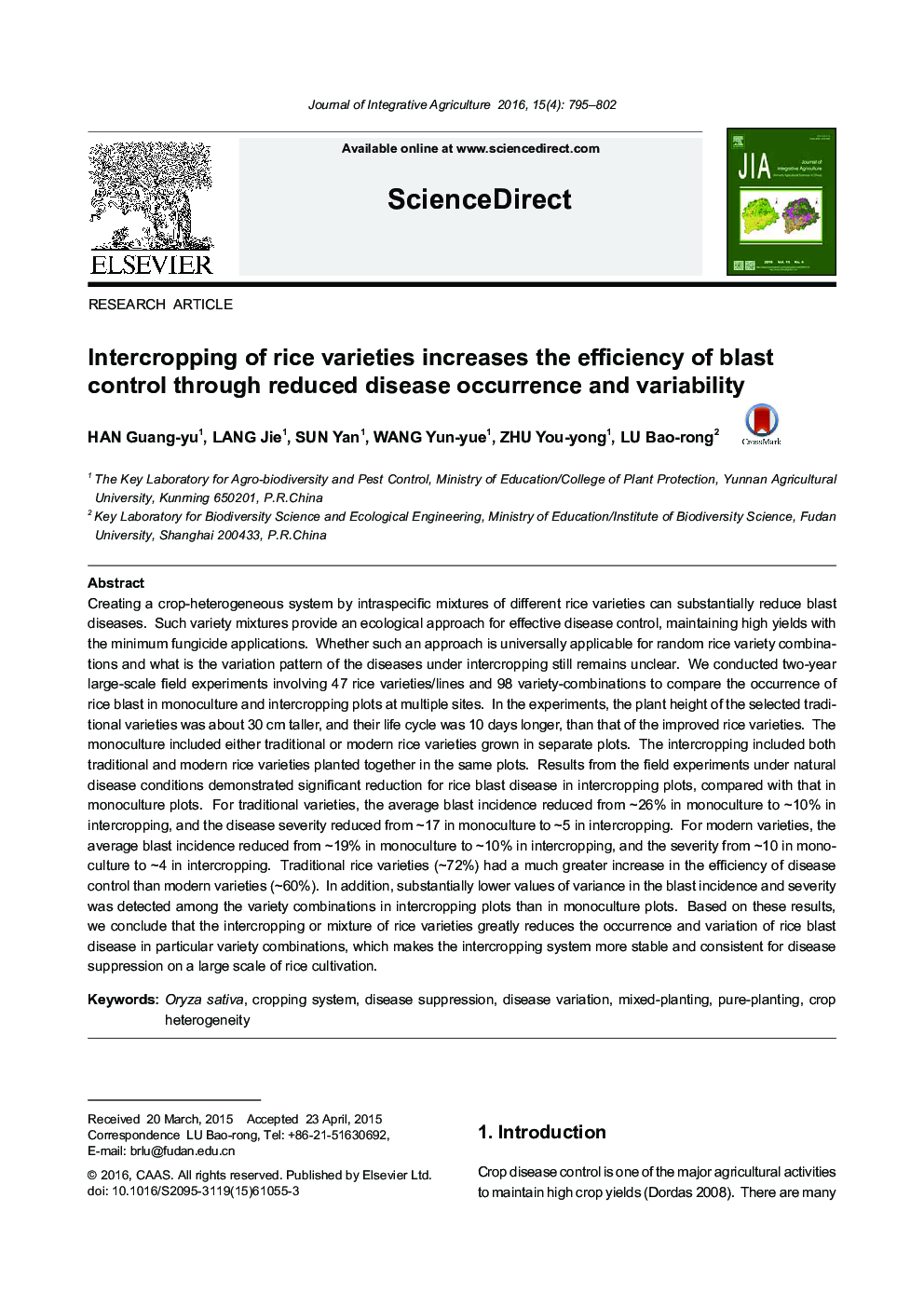| کد مقاله | کد نشریه | سال انتشار | مقاله انگلیسی | نسخه تمام متن |
|---|---|---|---|---|
| 10179977 | 1318700 | 2016 | 8 صفحه PDF | دانلود رایگان |
عنوان انگلیسی مقاله ISI
Intercropping of rice varieties increases the efficiency of blast control through reduced disease occurrence and variability
ترجمه فارسی عنوان
کشت مخلوط ارقام برنج باعث افزایش کارایی کنترل انفجار از طریق کاهش وقوع و تغییرات بیماری می شود
دانلود مقاله + سفارش ترجمه
دانلود مقاله ISI انگلیسی
رایگان برای ایرانیان
ترجمه چکیده
ایجاد یک سیستم محصول ناهمگن با ترکیبات درون گونه ای از انواع مختلف برنج می تواند به طور قابل توجهی باعث کاهش بیماری های انفجاری شود. چنین مخلوط های مختلف یک رویکرد اکولوژیک برای کنترل بیماری مؤثر است، حفظ عملکرد بالا با حداقل کاربرد های قارچ کش. این که آیا چنین رویکردی برای ترکیبات تصادفی تصادفی به طور جهانی قابل استفاده است یا خیر، مشخص نیست که الگوی تغییرات بیماریهای تحت کشت بینظیر هنوز مشخص نیست. ما دو ساله آزمایش های گسترده ای را انجام دادیم که حاوی 47 گونه / خطوط برنج و 98 ترکیب مختلف برای مقایسه انفجار برنج در کشت تک کشت و توطئه های کشت مخلوط در چندین سایت است. در آزمایشات، ارتفاع گیاه گونه های سنتی انتخاب شده حدود 30 سانتی متر بلندتر بود و طول عمر آنها 10 روز بیشتر از رقم بهبود یافته برنج بود. تک کشت شامل انواع برنج سنتی یا مدرن است که در جداول جداگانه رشد می کنند. کشت مخلوط شامل انواع مختلفی از برنج های سنتی و مدرن است که در همان قطعه ها کاشته شده اند. نتایج آزمایشات مزرعه ای تحت شرایط بیماری های طبیعی کاهش قابل توجهی را برای بیماری انفجار برنج در توطئه های کشت مخلوط، در مقایسه با مقادیر تک کشت انجام داد. برای گونه های سنتی، متوسط شیوع انفجار از 26 درصد در کشت تک کشت به ~ 10 درصد در کشت مخلوط تقلیل یافت و شدت بیماری از 17 در کشت تک کشت به ~ 5 در کشت مخلوط شده کاهش یافت. برای گونه های مدرن، شیوع انفجار به طور متوسط از 19 درصد در کشت تک کشت به ~ 10 درصد در کشت مخلوط، و شدت از ~ 10 در تک کشت به ~ 4 در کشت مخلوط. گونه های برنج سنتی (~ 72٪) افزایش کارایی کنترل بیماری را نسبت به گونه های مدرن (~ 60٪) افزایش دادند. علاوه بر این، مقدار واریانس در بروز و شدت انفجار در میان ترکیبات مختلف در توطئه های کشت مخلوط، بیشتر از توطئه های تک کشت بود. بر اساس این نتایج، ما نتیجه می گیریم که کشت مخلوط یا ترکیبی از گونه های برنج به طور قابل توجهی باعث وقوع و تنوع بیماری انفجار برنج در ترکیب های مختلف می شود، که باعث می شود سیستم کشت مخلوط برای کاهش بیماری در مقیاس بزرگ کشت برنج پایدار و سازگار باشد.
موضوعات مرتبط
علوم زیستی و بیوفناوری
علوم کشاورزی و بیولوژیک
علوم کشاورزی و بیولوژیک (عمومی)
چکیده انگلیسی
Creating a crop-heterogeneous system by intraspecific mixtures of different rice varieties can substantially reduce blast diseases. Such variety mixtures provide an ecological approach for effective disease control, maintaining high yields with the minimum fungicide applications. Whether such an approach is universally applicable for random rice variety combinations and what is the variation pattern of the diseases under intercropping still remains unclear. We conducted two-year large-scale field experiments involving 47 rice varieties/lines and 98 variety-combinations to compare the occurrence of rice blast in monoculture and intercropping plots at multiple sites. In the experiments, the plant height of the selected traditional varieties was about 30 cm taller, and their life cycle was 10 days longer, than that of the improved rice varieties. The monoculture included either traditional or modern rice varieties grown in separate plots. The intercropping included both traditional and modern rice varieties planted together in the same plots. Results from the field experiments under natural disease conditions demonstrated significant reduction for rice blast disease in intercropping plots, compared with that in monoculture plots. For traditional varieties, the average blast incidence reduced from ~26% in monoculture to ~10% in intercropping, and the disease severity reduced from ~17 in monoculture to ~5 in intercropping. For modern varieties, the average blast incidence reduced from ~19% in monoculture to ~10% in intercropping, and the severity from ~10 in monoculture to ~4 in intercropping. Traditional rice varieties (~72%) had a much greater increase in the efficiency of disease control than modern varieties (~60%). In addition, substantially lower values of variance in the blast incidence and severity was detected among the variety combinations in intercropping plots than in monoculture plots. Based on these results, we conclude that the intercropping or mixture of rice varieties greatly reduces the occurrence and variation of rice blast disease in particular variety combinations, which makes the intercropping system more stable and consistent for disease suppression on a large scale of rice cultivation.
ناشر
Database: Elsevier - ScienceDirect (ساینس دایرکت)
Journal: Journal of Integrative Agriculture - Volume 15, Issue 4, April 2016, Pages 795-802
Journal: Journal of Integrative Agriculture - Volume 15, Issue 4, April 2016, Pages 795-802
نویسندگان
Guang-yu HAN, Jie LANG, Yan SUN, Yun-yue WANG, You-yong ZHU, Bao-rong LU,
